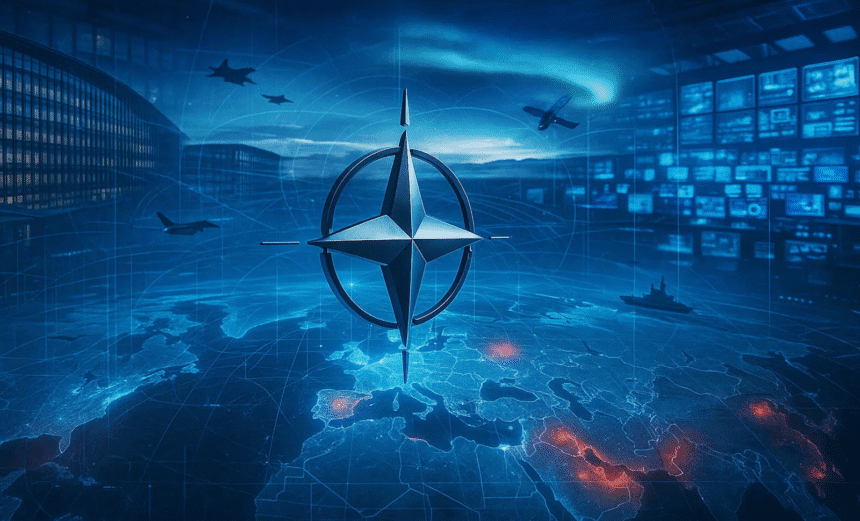As global tensions evolve and new threats reshape the international order, NATO stands at one of the most critical turning points in its 75-year history. Founded in 1949 in Washington, D.C. as a collective defense alliance against Soviet expansion, NATO has transformed into the world’s most powerful security bloc, now comprising 32 member states following the entry of Finland in 2023 and Sweden in 2024.
With its political headquarters in Brussels, NATO today faces a complex set of challenges, from Russia’s renewed military aggression and China’s strategic rise to non-traditional threats such as cyberwarfare, disinformation, AI-driven militarization and climate-related security risks. The future of NATO’s role in modern geopolitics is shaped not only by the “where” of current conflicts but by the “why” of global insecurity and the emerging competitions that define the 21st century.
The war in Ukraine remains the single largest catalyst for NATO’s renewed relevance. Russia’s 2022 invasion forced Europe to confront vulnerabilities that many believed had been buried since the Cold War. As a result, defense budgets skyrocketed; in 2014, only three NATO states met the 2% GDP defense spending target, whereas by 2025 the number is projected to reach 23 out of 32. Germany announced its historic “Zeitenwende,” Poland became one of Europe’s highest military spenders, and the Baltic states demanded an even stronger forward defense on NATO’s eastern flank. Meanwhile, NATO’s cooperation with Indo-Pacific partners- Japan, South Korea, Australia, and New Zealand- expanded due to shared concerns over China’s assertiveness, Taiwan Strait tensions, and the rise of hybrid threats affecting global supply chains and digital networks.
NATO’s modern agenda stretches far beyond conventional warfare. The alliance is investing heavily in emerging technologies, cyber defense, energy security, counter-terrorism, and space-based surveillance. Through its Defence Innovation Accelerator for the North Atlantic (DIANA), NATO aims to compete with China’s rapid advancements in artificial intelligence, quantum systems, robotics, and autonomous weapons. The nature of conflicts has shifted from battlegrounds to data systems, satellite networks, pipelines, and digital infrastructure, all of which NATO now considers core domains of collective defense. From cyberattacks targeting critical infrastructure to disinformation campaigns seeking to destabilize democracies, the threat spectrum has broadened dramatically.
Countries driving NATO’s next phase include the United States as the central military pillar; the United Kingdom as a leader in modernization, cyber capabilities and Ukraine support; Poland and the Baltic states pushing for stronger deterrence against Russia; Germany increasing its military readiness after decades of restraint; and Turkey providing crucial influence across the Middle East, the Caucasus and the Black Sea. Finland and Sweden, with their advanced intelligence, Arctic expertise and strong militaries, bring new strategic depth as NATO shifts attention to the High North, where climate change is opening new routes and strategic vulnerabilities.
The alliance’s future commitments focus on strengthening deterrence on the eastern front, deepening cooperation with Indo-Pacific democracies, integrating AI and space technologies into defense planning, protecting energy and digital infrastructure, and preparing for climate-related disruptions that could intensify global competition. NATO’s long-term support for Ukraine remains central, though full membership is still debated due to fears of escalating direct conflict with Russia. Nonetheless, NATO’s presence and decisions continue to shape global security trends, from influencing global defense spending patterns to defining military technology standards.
The future of NATO lies in its ability to remain united while managing simultaneous crises in Europe, the Middle East, Africa, and the Indo-Pacific. Internal disagreements, domestic politics within member states, and burden-sharing debates will continue to test alliance cohesion. However, experts agree that NATO’s next decade will be more global, technologically advanced, and strategically interconnected than ever before. The alliance’s evolution from a Euro-Atlantic military pact to a worldwide security network marks a defining shift in modern geopolitics. In an era of rising authoritarianism, unpredictable conflicts, and rapid technological change, NATO’s role and the choices it makes now will shape the balance of power for decades.


















